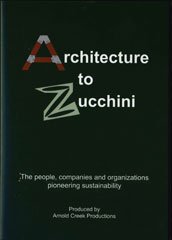
Architecture to Zucchini: The People, Companies and Organizations Pioneering Sustainability 2005
Distributed by Arnold Creek Productions, PO Box 2402, Lake Oswego, OR 97035; 503-246-2439
Produced by Arnold Creek Productions
Director n/a
DVD, color, 2 hrs.
Jr. High - Adult
Agriculture, American Studies, Architecture, Business, Careers, Economics, Environmental Studies, Ethics, Food, Management, Sociology
Date Entered: 02/01/2006
Reviewed by Meghann Matwichuk, Morris Library, University of DelawareFrom Architecture to Zucchini explores the definition of sustainability as well as its practical and theoretical implications for progressive businesses in the Portland, Oregon area. The video consists of twelve case studies, each between five and fifteen minutes in length, profiling various umbrella organizations which support sustainable business practices as well as the businesses themselves. The program examines sustainability and social responsibility through conversations with organizational leaders and company owners, and presents a useful picture of the challenges and rewards they encounter.
The video covers a wide variety of organizations. Its first four segments includes those whose mission it is to promote environmentally sound economic development in rural areas as well as those whose aim is to convene information-sharing activities for urban businesses on how to incorporate environmentally friendly practices into all aspects of their operations. Following are eight segments which profile the businesses themselves. These organizations range from those that are commonly associated with sustainable business practices (a grocery market that specializes in natural and organic foods) and other less-expected ventures (a local pizza chain, Hot Lips, which utilizes local farms, energy efficient machinery, and bicycles for their deliveries). There is a great deal of surprising information to be found in these vignettes as they examine the creative ways that company founders have become more socially responsible. These include partnerships with community organizations which train at-risk youth in the practices of green building and a community based bank who utilizes scientists to evaluate the ways business clients can use environmental and sociological soundness to help create competitive ventures.
Although the program presents a great deal of valuable information on a topic of increasing interest to those studying business and ecology, it suffers from low production values and a lack of overall focus. The production is visually flawed (possibly due to poor compression) – the edges of people and objects are conspicuously blocky. Instructors will find use in selecting specific vignettes to supplement teaching goals, however, the program could have been composed as a much more effective, instructive, and comprehensive documentary about the business sustainability movement with further editing and integration. Also, the majority of the information comes in the form of talking-head interviews (especially for the first four segments covering umbrella organizations dedicated to assisting sustainable businesses). Although the information and analysis presented is intriguing, the style of presentation is deadening and somewhat redundant as talking points are repeated numerous times by different speakers. Instructors may need to sift through this two-hour program in order to find relevant material, and so it is recommended with reservations.